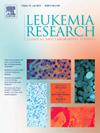Infectious complications in pediatric acute lymphoblastic leukemia treatment: A comparison of ALL-IC BFM 2009 vs. modified St. Jude total XV in a single-center retrospective cohort study
IF 2.2
4区 医学
Q3 HEMATOLOGY
引用次数: 0
Abstract
Infectious complications remain the major cause of treatment-related morbidity and mortality in pediatric patients with acute lymphoblastic leukemia (ALL). This study retrospectively compared the patterns of infection in children treated with either the modified St. Jude Total XV protocol (n = 181) or the ALL-IC BFM 2009 protocol (n = 61) at a single center. Although the overall number of infection episodes was similar between the two groups, their distributions across treatment phases differed markedly. The ALL-IC BFM 2009 protocol was associated with a significantly greater incidence of infections during the induction phase, particularly in high-risk patients, who often presented with skin and gastrointestinal tract infections. In contrast, modified St. Jude Total XV protocol presented a greater infection risk during the re-induction phase. Gram-positive bacteria, especially Staphylococcus epidermidis, were the most frequently isolated pathogens in both cohorts, although the BFM group exhibited a higher proportion of gram-negative infections. The rates of documented viral infections in BFM cohort and modified St. Jude Total XV cohort were 21.4 % vs 9.2 %, respectively. Invasive fungal infection rate was found as 6.7 % in the modified St. Jude group and 4.0 % in the BFM group is in line with the literature. Multivariate analysis confirmed that severe neutropenia and the presence of a central venous catheter were strong independent predictors of infection frequency. These findings underscore protocol-specific differences in infectious risk profiles and emphasize the importance of tailored supportive care strategies in the management of pediatric ALL.
儿科急性淋巴细胞白血病治疗中的感染并发症:一项单中心回顾性队列研究中ALL-IC BFM 2009与改良St. Jude total XV的比较
感染性并发症仍然是急性淋巴细胞白血病(ALL)患儿治疗相关发病率和死亡率的主要原因。本研究回顾性比较了在单个中心接受改良St. Jude Total XV方案(n = 181)或ALL-IC BFM 2009方案(n = 61)治疗的儿童感染模式。尽管两组之间感染事件的总次数相似,但它们在治疗阶段的分布明显不同。ALL-IC BFM 2009方案与诱导期感染发生率显著增加相关,特别是在经常出现皮肤和胃肠道感染的高危患者中。相比之下,改良的St. Jude Total XV方案在再诱导阶段的感染风险更大。革兰氏阳性细菌,尤其是表皮葡萄球菌,是两个队列中最常见的分离病原体,尽管BFM组表现出更高比例的革兰氏阴性感染。BFM队列和改良St. Jude Total XV队列中记录的病毒感染率分别为21.4% %和9.2% %。改良St. Jude组侵袭性真菌感染率为6.7 %,BFM组为4.0 %,与文献一致。多因素分析证实,严重中性粒细胞减少和中心静脉导管的存在是感染频率的强大独立预测因素。这些发现强调了不同方案在感染风险概况方面的差异,并强调了在儿科ALL治疗中定制支持性护理策略的重要性。
本文章由计算机程序翻译,如有差异,请以英文原文为准。
求助全文
约1分钟内获得全文
求助全文
来源期刊

Leukemia research
医学-血液学
CiteScore
4.00
自引率
3.70%
发文量
259
审稿时长
1 months
期刊介绍:
Leukemia Research an international journal which brings comprehensive and current information to all health care professionals involved in basic and applied clinical research in hematological malignancies. The editors encourage the submission of articles relevant to hematological malignancies. The Journal scope includes reporting studies of cellular and molecular biology, genetics, immunology, epidemiology, clinical evaluation, and therapy of these diseases.
 求助内容:
求助内容: 应助结果提醒方式:
应助结果提醒方式:


